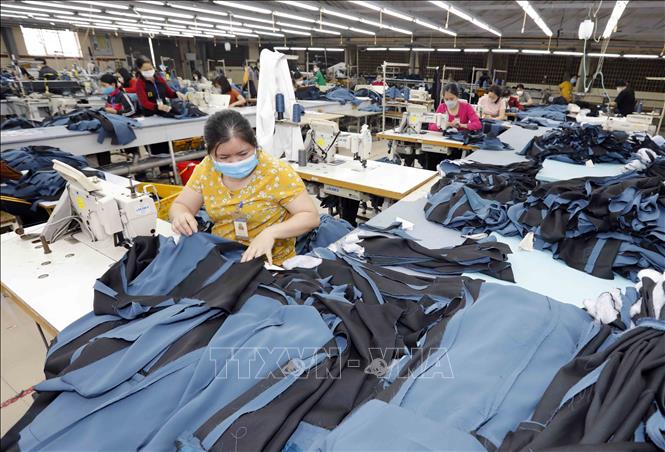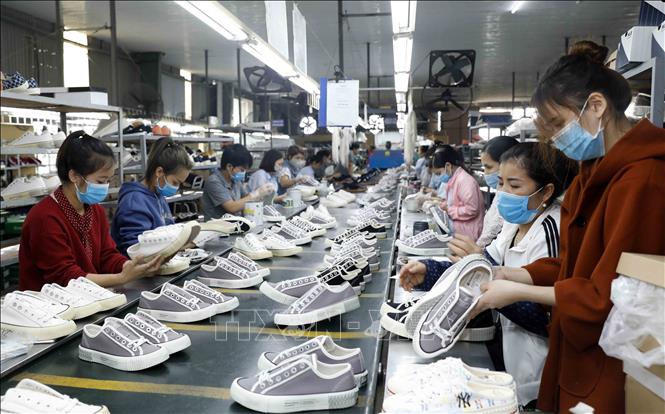
Sewing goods for export to the Spanish market at Ho Guom Garment Company (Hung Yen). Documentary photo: Tran Viet/VNA
Many opinions from businesses and experts believe that, in order to enter the EU market with new criteria, enterprises themselves must improve their own technology, meet material traceability and ensure environmental safety.
New rules of the game
According to information from the WTO Center, the Vietnam Chamber of Commerce and Industry, this new strategy includes many elements to create momentum for the textile industry, for example, products must be designed and manufactured to they can last longer, can be repaired and then reused - in other words, in a cycle. In addition to the design criteria, the Ecodesign Regulation also includes the development of digital product passports that, in addition to conventional information, must inform consumers of chemical content, repairability and fiber composition.
It is expected that the final ecodesign regulation must be approved by the European Parliament and the Council, expected by the end of 2023, before the first criteria for other product groups are determined, expected in year 2024.
Europe is a traditional and key market for the textile and footwear industry. Especially, with the EU-Vietnam Free Trade Agreement (EVFTA), businesses have made good use of incentives to boost exports to this market. However, it must be recognized that the enterprises themselves have had a change in product quality, along with compliance with market regulations.
According to Ms. Phan Thi Thanh Xuan, Vice President and General Secretary of the Leather, Footwear and Handbag Association (Lefaso), to enter the EU market, product quality requires higher safety than products going to other markets. , therefore, corporate compliance must also improve. Followed by regulations on import and export procedures, especially proving the rules of origin, enterprises must also participate in training and enforcement. In addition, factors related to sustainable development, when products are exported to the EU, require factories to meet environmental and occupational safety conditions. If these criteria are met, customers from the EU can import.
To meet those conditions, enterprises must also improve and renew the quality of human resources, as well as the system of production facilities, especially using clean energy and green technology to meet the standards. The footwear origin criteria in the EVFTA is quite similar to the origin criteria in the EU's new rules of origin for Vietnamese leather and footwear, so businesses are familiar with it and respond well," said Ms. Thanh Xuan.
According to Mr. Nguyen Xuan Duong, Chairman of Hung Yen Garment Company, the European market has introduced green standards in terms of labor, materials and production conditions. These requirements are very strict. Vietnamese garment products must meet the requirements of ecological design to increase durability, reusability, repair and recycling. Therefore, enterprises must comply, from input materials to the production process.
To ensure exports to the EU market, domestic enterprises must comply with strict regulations. However, according to Mr. Vu Duc Giang, Chairman of the Vietnam Textile and Apparel Association (VITAS), businesses have prepared and can adapt to new regulations from the EU market. Because large enterprises that have exported to the EU, complying with the rules in the EVFTA, are already familiar with these things. Only small businesses, which are weak in technology and production capacity, are struggling.

Producing shoes for export to the European market at Ha Tay Textile Chemical Co., Ltd. Photo (documentary): Tran Viet/VNA
Overcoming difficulties to increase exports
Although businesses have been quite well prepared, meeting standards and taking advantage of EVFTA to boost exports. However, there are still many difficulties, especially for small and medium enterprises.
Ms. Phan Thi Thanh Xuan said that since the EU-Vietnam Trade Agreement was implemented, the leather and footwear industry has made good use of this agreement. Previously, the export turnover to the EU market reached from 25-28%, now it has increased to 30% of the proportion of export turnover in the total export turnover of Vietnam. "We expect small and medium enterprises will also expand production to target the EU market, but it will be very difficult," Ms. Xuan said.
The production of raw materials for the leather and footwear industry has recently expanded to meet the origin and create better added value. Previously, the localization rate was only 45%, now it has reached more than 55%. For canvas shoes, domestic enterprises have taken the initiative of 100%, and sports shoes have been active from 70-80%.
However, the implementation of new regulations from the EU is still difficult for small and medium enterprises in the leather, footwear and textile industries. Because according to Ms. Phan Thi Thanh Xuan, large enterprises have exported before, complying with new regulations on recycled and environmentally friendly products, publicizing information on the use of chemicals, fabrics, etc. However, for small businesses with limited capital and capacity, it will be more difficult to change and upgrade to comply with regulations.
Enterprises must fully ensure safety criteria when exporting to the EU and this greatly affects technology investment. The second is to meet sustainable development standards related to environment and labor. Enterprises must also improve compliance, meet rights and obligations with employees, on the other hand, on the environment, must work towards the use of clean energy, application of green and progressive technologies so as not to affect the environment. enjoy the environment.
Order opportunities from the EU for the leather, footwear and textile industry are still very good. However, in order to export, in addition to product origin, using recycled materials, it is necessary to meet labor and environmental standards.
Mr. Vu Duc Giang said that in order to penetrate the EU market, businesses must meet much higher standards, both in terms of social responsibility and environmental friendliness. An important solution is to invest in technology because high technology will solve the labor deficit and also the environmental problem.
Regarding green growth, the President of VITAS said that the rate of clean energy use in some places accounts for 31-32% of the total electricity consumption. Meanwhile, the number of textile and garment enterprises using clean energy has increased to 60-65%, either buying electricity by themselves or investing in installing solar energy projects themselves. Mr. Giang said that in the next 5 to 7 years, 100% of textile and garment companies can fully meet the clean energy target.
Experts say that, in the long term, improving product quality is a key factor to ensure sustainable export growth. Therefore, in addition to the efforts of enterprises and state management agencies, there should be solutions to encourage investment in supporting industries and centers for supplying raw materials. The EU is tightening standards on environmental protection, so building a modern general specialized waste treatment system is the direction that localities need to promote.
In particular, the Vietnam Textile and Apparel Association has also asked the Government to soon approve the "Strategy for development of the textile and footwear industry to 2030, with a vision to 2035" to create conditions for the formation of large industrial parks with high potential for investment. centralized wastewater treatment, advanced technology and green technology to attract investment in textile dyeing, solve bottlenecks in fabric supply for garment export, meet origin requirements for tax incentives from trade agreements. free trade agreement…
Duc Dung (TTXVN)